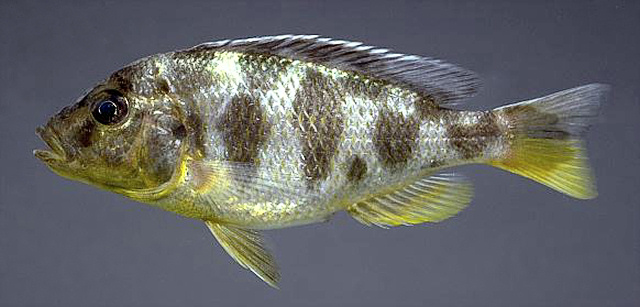

Nimbochromis venustus, the least specialized species currently placed in the genus Nimbochromis. Photo copyright © 1997 by M. K. Oliver. This attractive fish is occasionally sold to aquarists under the name "giraffe Hap," presumably for its coloration and markings (certainly not for its long neck!). If my cladistic analysis of Nimbochromis is correct, then the blotches on the flanks of the more derived members of the group (such as N. polystigma) are derived from the breaking up of four wide vertical bars below the dorsal fin. These four bars are seen intact in Placidochromis johnstonii and have begun to fragment in many (but not all) individuals of P. milomo. In Nimbochromis venustus, the four bars below the dorsal fin always break up into upper and lower segments, often somewhat diamond-shaped, which are slightly out of vertical alignment, as seen here.
Konings (1995c: 275) has some fascinating observations on the behavior of N. venustus; observations that are also phylogenetically important:
"Nimbochromis venustus is known from many locations around the lake but prefers deeper regions — usually deeper than 15 meters — than its close relative N. livingstonii. It has adopted a somewhat similar hunting tactic to N. livingstonii, but is, however, never seen lying on its side; instead it remains motionless after ploughing slightly into the sandy bottom after spotting some small fishes. It stays in this position for a long time, waiting for prey to come within reach. The yellow coloration probably functions as an attractant for juvenile cichlids. Because of its behaviour N. venustus has, like its congener, been given the native name 'kaligono' which means 'sleeper'. The 'Venustus' also feeds on invertebrates and preys on small fishes in a more normal manner. It uses its special hunting technique only when a group of tiny cichlids is encountered."

| Last Update: 7 November 2010
Web Author: M. K. Oliver, Ph.D. Copyright © 1997-2021 by M. K. Oliver, Ph.D. - ALL RIGHTS RESERVED |